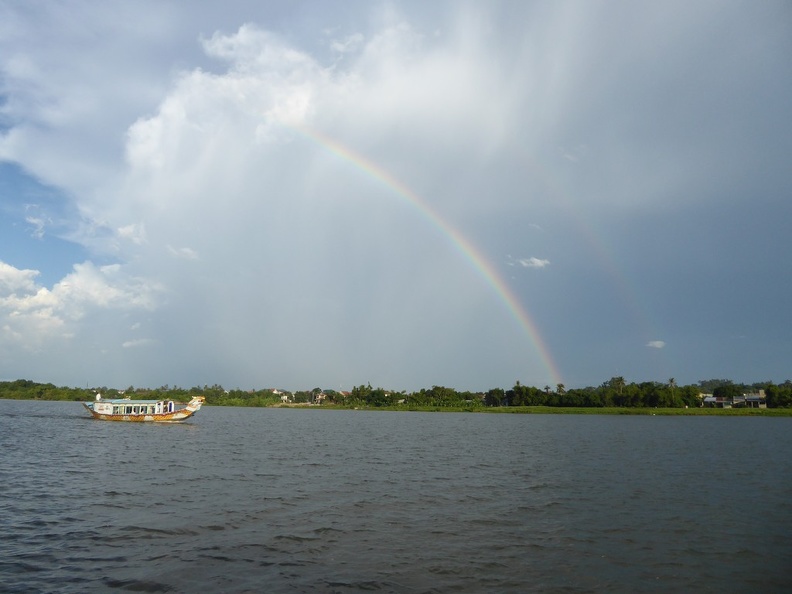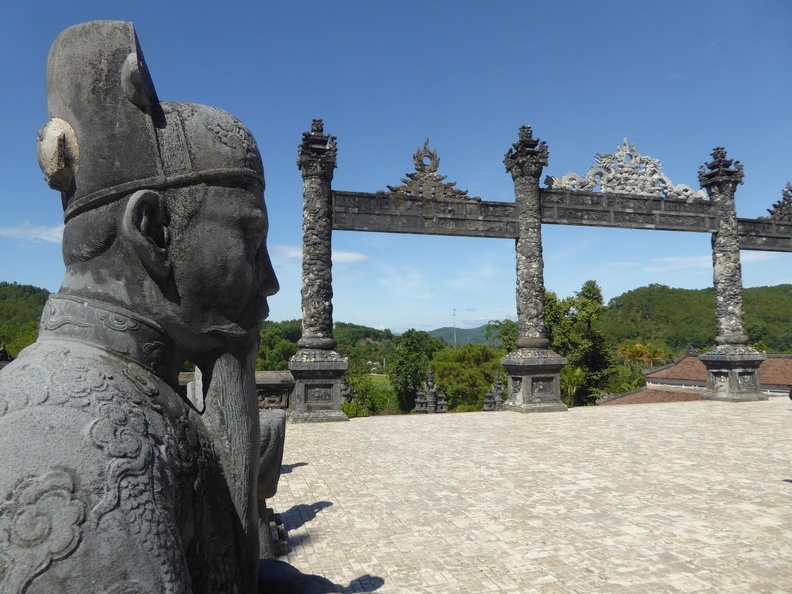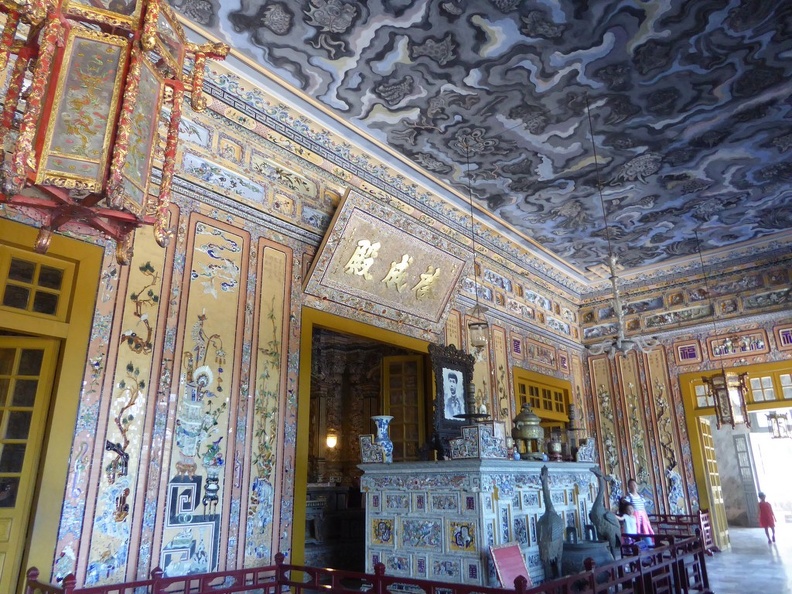Located not too far off the Forbidden city in the heart of Hue city are two historical landmarks. Situated by the northern bank of the Perfume river just 3km from the Ancient Citadel is the Thien Mu Pagoda. The pagoda is also known as The Pagoda of the Celestial Lady. Moreover, the Pagoda itself is an unofficial symbol of the city which you can see in many tourist materials.
Thien Mu Pagoda
The historic 7-storey pagoda is an octagonal 21-meter-high tower sitting on Hà Khê hill. Also, it is part of a Buddhist Monastery in the heart city of Huế. The Buddhist temple and Pagoda through history has become an essential part of Hue City. Also, access to the Pagoda involves a short climb up about 3 flights of steps offering you overlooking views the Perfume river itself.
The Buddhist monastery behind the temple is an active one. Moreover, it is home to about a hundred monks in service to Buddha comprising of both young and old deciphers. With a working temple and altar, the temple is open to all daily. Notably, there is no entry fee and all are welcome. The temple itself is fresh tranquil and quiet tucked away from the buzzing polluted streets of Hue.

Exploring the Buddhist monastery
You can take a stroll through the monastery inner grounds, past several temple buildings, accommodation quarters, bonsai gardens and koi ponds. Additionally, here, you can see monks and young deciphers skittering around the monastery grounds in their daily line of work.
The pagoda offers a perfect combination of artificial architectural work and picturesque nature. Moreover, the pagoda was built in 1601 on the order of the first Nguyễn lords of the Nguyễn Dynasty for Nguyễn Hoàng. He was the governor of Huế during the era. Also, the monastery behind was then later expanded and refurbished to the current grounds it is today.
The Pagoda has historical significance and had seen it fair share as a site popular for anti-government protest, particularly in 1955, where President Ngo Dinh Diem had favoritism towards Catholics and expressed discrimination against Buddhists in the public service and distribution of aid.
The temple also houses in a small sheltered shed Thich Quang Duc’s blue Austin motor car which he drove to Saigon in 1963 and set himself on fire alive while in the lotus medication position against the President Diem regime. This was the first of a series of self-immolations by members of the Buddhist clergy, which garnered much international attention.
At the end of the Monastery Grounds is a tome and resting place of Hòa Thượng Thích Ðôn Hậu, the abbot who oversaw the reconstruction of the pagoda and temple grounds from 1907. The it sits facings a nice green manicured lawn complete with a pond and flanked by hedge cutouts of animals and pine trees at the end of the Monastery grounds.
View over the Perfume river
Moreover, the Monastery is also a good vantage point to take a short ferry boat ride along the Perfume river to enjoy the sights of Hue from the river itself.
You can do so using the number of blue (Tourist) boats which can send you on a single or round trip along the Perfume river.

View more photos of Thien Mu Pagoda Monastery here.
Khai Dinh King Tomb
Being renowned as the most royal city in Vietnam, Hue is a location where many ancient emperors were called to rest. As such, there are a number or royal tombs of scattered along the banks of the Perfume River. Additionally, notable figures include Minh Mang, Tu Duc, Dong Khanh and Khai Dinh, the 12th Emperor of the Nguyễn Dynasty in Vietnam.

Furthermore, all these emperors have their tombs houses in large elaborate complexes, often on each of their own hills. The Minh Mang Tomb was built in 1843 on Cam Khe Hill which we are on. It sits on an area of 18 hectares with a 3-meter-high defended wall, and nearly 20 architectural constructions. Lying in the middle of a pine forest, Tu Duc Tomb belongs to Duong Xuan Moutain, 8km far from Hue.
Exploring the Mausoleum grounds
The Ứng Mausoleum or the Tomb of Khải Định is one such place. Perched on top of a hill (Chau Chu mountain) is the Khai Dinh King Tomb. As previously highlighted, it was built for the 12th Emperor of the Nguyễn dynasty, Khải Định. Moreover, construction started from 1920 and it was completed in 1931 by Bảo Đại, Khải Định’s successor. Bảo Đại was conceived with one of Khải Định concubines following his two failed marriages beforehand.
A formidable row of stairs greets you at the mausoleum entrance. Large open stairways lead you up on various intermediate platforms housing areas of interests. This includes areas such as a dragon altar, as well as a number of stone figures reminiscent of the Tang dynasty terracotta figures.
Notably, the walls of the various shrines and leading up to the main tomb building are all made out of weathered dark stone, giving them a rather worn an ancient look, painting how most of these structures standing against time against the hard and hot Vietnamese weather.
Khai Thanh Palace

Close to the top of the outdoor staircases leads you straight up to the Khai Thanh Palace main tomb building. The Palace is the actual Mausoleum grounds where Khải Định body is laid to rest. Additionally, the interior of the Tomb feature a blend of Western and Eastern architectures with several intricately designed glass and porcelain art decorations on the walls. Also, large lanterns lights hang from the high ceilings, with the ceilings of the palace itself is decorated with nine intricate dragons.
Moreover, before his 1925 death, Khải Định visited France. Hence, it was where he was likely influenced by the European architectural styles there. Notably, this imported French style is largely translated and evidenced by stark European design architecture which did not feel out of place in his Oriental mausoleum.
Additionally, the Palace building itself is flanked by two large halls. One hall serves as an entrance and introductory video screen area, with a central hallway leading up to the Tomb room located in the rear of the building. The other room is an artifact display room. Also, a couple of rooms on the other far end of the Palace house several old artifacts and furniture. These display items are all tucked behind glass display cabinets. They are manned by a caretaker who be keen to explain the artifacts to you in Vietnamese.
In conclusion, you will be good for a visit to the Tomb in under an hour. When you are there, do take time to enjoy the green countryside and mountain views from Chau Chu mountain too.
View more photos of Khai Dinh King Tomb.
























